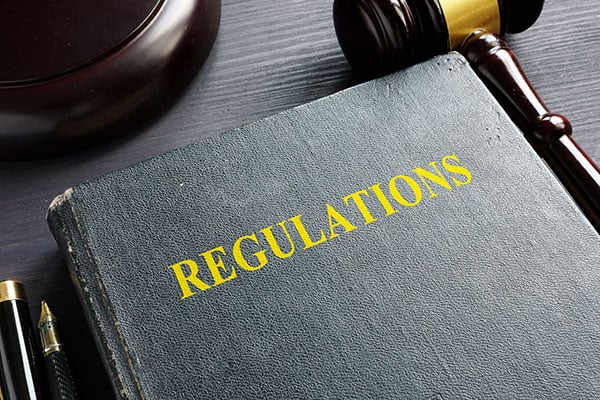In our final segment in our series on Rule Development and Enforcement for Communication Associations, we delve into the importance of implementing a due process procedure when enforcing rules in your community association and taking advantage of some other resources you have available to you.
DEVELOPING AND IMPLEMENTING A DUE PROCESS PROCEDURE FOR ENFORCING RULES: This section will provide an introduction to the enforcement of rules, and will cover the following areas:- Use of a due process procedure to enforce rules
- Alternative dispute resolutions
- Internal resources for enforcing rules
- External resources for enforcing rules
- Enforcement of architectural guidelines
- Architectural variance or change requests
Use of a Due Process Procedure to Enforce Rules
A due process procedure is a formal process designed to protect the rights of all parties involved. There are several benefits to using a due process procedure to enforce community association rules:
- All alleged rule violations are handled in the same manner
- Use of a due process procedure is recognized by the courts as an indication of legally valid rule enforcement
- The vast majority of rule violations can be resolved with this procedure, thus avoiding going to court
- The opportunity to be heard in a non-threatening fact-finding forum is often enough to result in a person’s voluntary decision to obey a rule
- Such a procedure provides an opportunity to explore alternative means to resolve a violation
Basic Steps in a Due Process Procedure for Handling Alleged Rule Violations: The following are the basic steps in a community association’s due process procedure for handling alleged rule violations. If the violation is resolved after any of the steps, it is not necessary to continue the enforcement process. With all steps, be sure to check your state statutes or governing documents, or consult with your attorney, for guidance with the formal enforcement process, as not all of these may be applicable for your association.
- Consider calling the resident or sending a courtesy letter to resolve the violation. While phoning a resident is the best customer service step to take, it may prolong the due process procedure if state statutes or governing documents require that the first formal step must be a cease and desist letter.
- Issue a formal “Cease and Desist” letter by certified mail which contains:
a) A specific description of the alleged violation
b) The action required to resolve the alleged violation
c) A specific time within which the alleged violation must be corrected
d) The penalty (sanction) which may be imposed after a hearing if the alleged violation is not corrected within the stated time (specified by state statute, your governing documents or board resolution)
- Issue a hearing notice if the alleged violation is not resolved within the stated time. This is a written notice to an alleged violator that a hearing will be held to consider the alleged violation.
- Hold the scheduled hearing if the alleged violation is not resolved within the stated time. This is a fact-finding session. It is an inquiry into the allegations and an investigation of them. A hearing should be viewed as an opportunity for both the association and the alleged violator to hear the input of the other party, not to engage in additional conflict.
- Issue a decision after the hearing is held. The hearing panel determines the facts: whether a rule has been violated, the penalty to be imposed (if any), and the enforcement date of the penalty (if any). The hearing panel then issues this information in the form of a decision. A hearing panel may find an alleged violator to have committed a violation or not - or decide that not enough clear evidence was submitted to allow the panel to reach a clear decision.
- Allow for an appeal of a decision. An appeal is a request for a review of a case by a higher authority. For example, if the hearing panel is a committee, the board of directors acts as the higher authority. If the board of directors is the hearing panel, the alleged rule violator must appeal to an authority outside the community association; for example, alternative dispute resolution.
If applicable legal sources allow, you may shorten the due process procedure by combining the “cease and desist” letter with an imposition of a penalty and a statement of the alleged violator’s right to a hearing to waive (dismiss) the penalty. If the alleged violator does not request a hearing within the stated time, the party is understood to have accepted the penalty. If the party does not fulfill the penalty, then a hearing is scheduled.
Check your governing documents carefully. Many recent documents specify a “due process” procedure which would prevail. Also, check your state statutes to determine whether deliberations can be held in private or must remain open and if there are regulations regarding the issuance of the findings of the panel.
Alternative Dispute Resolutions
A number of community associations are turning to alternative dispute resolution (ADR) as a means of encouraging people to comply with rules and guidelines. It involves submitting a dispute to a trained, uninvolved third party for assistance with solving a problem. The third party’s decision may be nonbinding, or the third party may merely act as a facilitator. However, this approach can be a more efficient and effective way to resolve a dispute than a drawn-out lawsuit.
An alleged rule violator might consider ADR if he or she is dissatisfied with the community association’s decision or appeal verdict. A community association might propose ADR when confronted with a difficult rule enforcement situation or the possibility of prolonged litigation. In many jurisdictions, ADR is either required or encouraged before filing suit or during the discovery process after the lawsuit was filed - but before trial.
How Arbitration Differs from Mediation: Arbitration is a process in which a third party (the arbitrator) renders a decision as to the respective liabilities of all parties. The object is not to reach a settlement; instead, the arbitrator ultimately makes a ruling. It is an adversarial process that results in the same “win-lose” or “lose-lose” that you would see in litigation. The arbitration can be binding or non-binding; a binding arbitration typically cannot be appealed.
In contrast, mediation is a non-adversarial process that is intended to bring about a “win-win” resolution. A neutral third party (a mediator) attempts to guide the parties into reaching a resolution that is favorable to everyone. Like arbitration, mediation can be binding or nonbinding, depending on the terms agreed upon between the parties before the session begins. The mediator does not attempt to blame either party and should not take sides. However, the mediator will often give his/her opinion on the outcome of the case, should it go to trial, in order to facilitate settlement. A good mediator also will attempt to make the parties see the realities of their position.
Internal Resources for Enforcing Rules
There are a number of internal resources a community can use to encourage an owner or tenant to conform to community association rules, as allowed by the governing documents and applicable state and local statutes:
- Suspension of owner’s voting rights: While mild, a community association may use this to encourage rule violators to conform to association rules.
- Suspension of the use of recreational facilities and common areas: Uses the community’s resources to encourage someone to conform to association rules.
- Fines: Be sure your community association has the authority to impose and collect fines.
- Eviction: The process of physically removing a tenant (not an owner) from a property. This process involves the local court system and use of an attorney.
- Self-help: Self-help means the community association takes action to correct the violation itself.
External Resources for Enforcing Rules
Community associations can also draw on resources within the broader community to help them enforce association rules. In certain situations, it may be better to have someone else wear the black hat instead of the association and its management. Local government agencies and municipal services can be great resources for enforcing rules. Take the time to build working relationships with each of the following parties.
- Local Health Department: Your local health department can be asked to enforce the local health code. Possible areas of violation include the number of occupants in a unit, internal use of a unit or storage on a lot, or pervasive stench or pet feces.
- Local Zoning Department: This local agency can assist with enforcement of such rules as a fence or shed regulations, setback restrictions, restrictions on commercial use of dwellings, and removal of vehicles, boats, and trailers.
- Local Police Department: In some jurisdictions, the police will enforce traffic regulations or tow violators of the community’s parking rules. The police can also help with noise control and suspected illegal activity. It is a good idea to develop a good working relationship with your local police department before you need its help
. . - Local Fire Department: Your local fire department will help with enforcement of fire lanes and the removal of hazardous materials.
- Local Building/Housing/Property Standards Department: These terms refer to the local government office that issues building permits. They may be able to help if a unit is in violation of an existing building, plumbing, fire or electrical code.
- Local Animal Shelter or Animal Control Officer: This agency is a good source of information on types of pets and weight classifications when your community association is defining rules for pets. You can also request that this agency patrol your community for animals in violation of its pet rules.
Enforcement of Architectural Guidelines
A community’s enforcement of architectural guidelines can be upheld in a court of law. The keys to the successful enforcement of architectural guidelines are the same as the keys to the successful enforcement of other rules. The board should refrain from turning a blind eye toward violations. They should report any known violations to the manager promptly. If unapproved architectural changes are permitted to exist, the association may be hindered if it later tries to enforce the rule that was violated.
Architectural Variances and Exceptions
One resource for successfully enforcing architectural guidelines is an established process for handling architectural variance or exception requests. Prepare and publish an architectural variance request form. Consider including a neighbor awareness section that requires the applicant seeking the variance to obtain the signatures of neighbors indicating they have been informed of the pending changes.
- When considering requests for variances:
- determine the direct impact the violation has on the value or purpose of the association
- make sound business decisions in keeping with the best interests of the community and its members
- document the decisions for making the variance or exception
Want to read from the beginning? Click here to read Part 1 of Rule Development and Enforcement.





